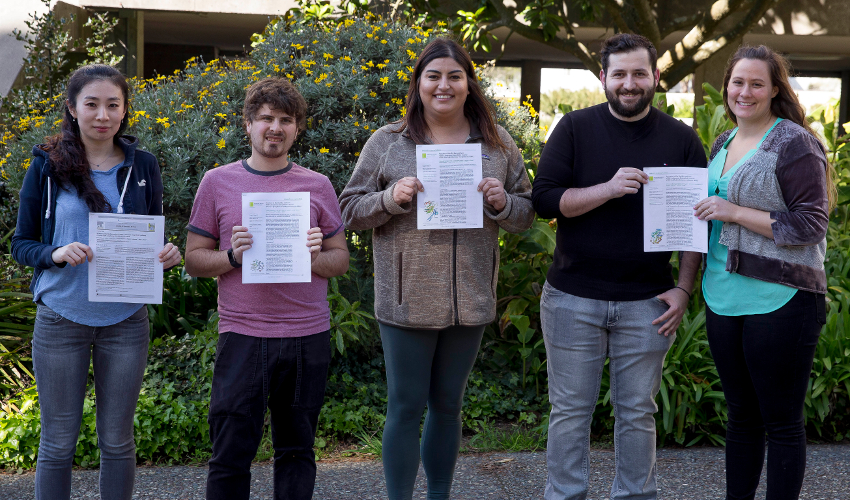Biochemistry grad students go above and beyond with publications

Five students display the scientific papers they published from their coursework
Studies describe bacterial proteins that could aid antibiotic discovery
Even after a scientist wraps up a piece of research, getting it published in a scientific journal can take months or years. So it’s rare that a student’s coursework ends up as a scientific publication. But in the Spring 2017 semester, a class of eight San Francisco State University students managed it — four times over.
“It’s important to know that you can challenge your students,” said Assistant Professor of Chemistry and Biochemistry Misty Kuhn, who taught the class. “And they’re probably going to exceed your expectations.”
Before the Spring 2017 semester, Kuhn was preparing to teach a master’s-level course about the structures and functions of protein molecules. It was her first time teaching the course, and she had an idea for how to make it unique. Left over from her time as a postdoctoral researcher at Northwestern University was some data that still needed to be analyzed — why not make use of it, and organize the semester around doing real scientific research?
It was a chance to show students what science is really like. But Kuhn wasn’t certain she could keep the students interested through a whole semester of studying a single protein. The students, including Ha Tran, weren’t sure either. “In the beginning, I was kind of worried about the class,” Tran said.
But the potential to get a published paper on their resume was enticing, and the eight students rose to the challenge. Working in small teams, they focused on their assigned proteins, learning to use specialized computer programs to analyze the molecules’ structures in three dimensions and comparing them to better-understood proteins to map out each loop, helix and turn.
The students published four separate papers, each concerning one protein: Three papers (here, here and here) were published in the journal Acta Crystallographica Section F, and one (here) in the Journal of Structural Biology. Students were lead authors on each paper, and they collectively managed to analyze and write descriptions of the structures of four different proteins, all belonging to a single pathway in bacteria.
The proteins they studied act one after another to create a kind of sugar molecule that becomes attached to the bacterium’s outer surface, its “cell wall.” The process may be important to understand because it doesn’t exist in humans, making it a potentially useful target for antibiotic drugs. “You’re trying to find a spot in the bacteria that you can target without affecting humans,” Kuhn explained. “And the cell wall is a big target, because bacteria need it to survive.”
While learning about those proteins, the class got to see a side of science most courses never touch on. They were faced with long hours studying the same topic, uncertainty at every turn and setbacks that forced them to improvise. Even after they got their final grades, it took months of effort to deal with revisions and get the manuscripts published. But student Jennifer Macias says it was worth it. “I think more classes should be like this, where we can build ourselves up,” Macias said.
And now that the students have conquered this challenge, they’re determined to keep going. “It was really demanding,” said student Alexander Stergioulis. “But as soon as you get the paper published, it makes you want to do more.”